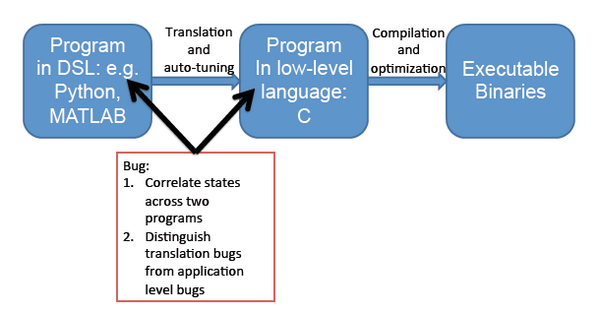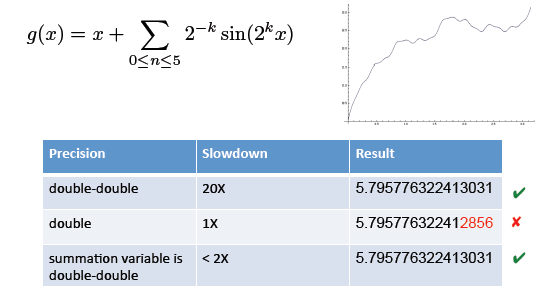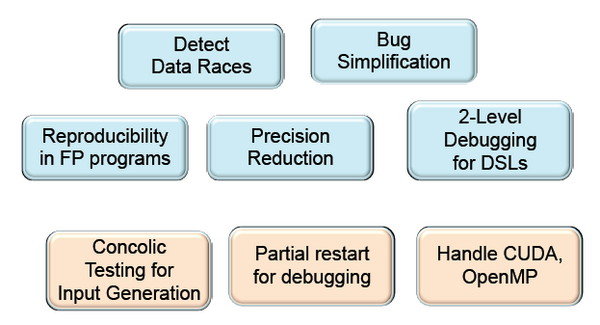CORVETTE
From Modelado Foundation
| CORVETTE | |
|---|---|
 | |
| Team Members | UC Berkeley, LBNL |
| PI | Koushik Sen (UC Berkeley) |
| Co-PIs | James W. Demmel (UC Berkeley), Costin Iancu (LBNL) |
| Website | CORVETTE |
| Download | {{{download}}} |
Program Correctness, Verification, and Testing for Exascale or CORVETTE
Team Members
Researchers
Postdoctoral Researchers
Graduate Student Researcher
Motivation
- High performance scientific computing
- Exascale: O(106) nodes, O(103) cores per node
- Requires asynchrony and “relaxed” memory consistency
- Shared memory with dynamic task parallelism
- Languages allow remote memory modification
- Correctness challenges
- Non-deterministic causes hard to diagnose correctness and performance bugs
- Data races, atomicity violations, deadlocks …
- Bugs in DSL
- Scientific applications use floating-points: non-determinism leads to non-reproducible results
- Numerical exceptions can cause rare but critical bugs that are hard for non-experts to detect and fix
- Non-deterministic causes hard to diagnose correctness and performance bugs
Goals
Develop correctness tools for different programming models: PGAS, MPI, dynamic parallelism
I. Testing and Verification
- Identify sources of non-determinism in executions
- Data races, atomicity violations, non‐reproducible floating point results
- Explore state-of-the-art techniques that use dynamic analysis
- Develop precise and scalable tools: < 2X overhead
II. Debugging
- Use minimal amount of concurrency to reproduce bug
- Support two-level debugging of high-level abstractions
- Detect causes of floating-point anomalies and determine the minimum precision needed to fix them
Publications
- Fast Reproducible Floating-Point Summation. J. Demmel and H.D. Nguyen. In Proceedings of the 21st IEEE Symposium on Computer Arithmetic (ARITH'13), Austin, TX, April 2013.
- Numerical Accuracy and Reproducibility at ExaScale. J. Demmel and H.D. Nguyen. In Proceedings of the 21st IEEE Symposium on Computer Arithmetic (ARITH'13), Austin, TX, April 2013.
- Scaling Data Race Detection for Partitioned Global Address Space Programs. C. Park, K. Sen, C. Iancu. In Proceedings of the International Conference on Supercomputing (ICS'13), Eugene, OR, June 2013.
- Precimonious: Tuning Assistant for Floating-Point Precision. C. Rubio-González, C. Nguyen, H.D. Nguyen, J. Demmel, W. Kahan, K. Sen, D.H. Bailey, C. Iancu, and D. Hough. In Proceedings of the International Conference for High Performance Computing, Networking, Storage and Analysis (SC'13), Denver, CO, November 2013.
- Parallel Reproducible Summation. J. Demmel and H.D. Nguyen. To appear in IEEE Transaction on Computer, Special Section on Computer Arithmetic 2014.
Technical Presentations
Software Releases
Testing and Verification Tools
Scalable Testing of Parallel Programs
- Concurrent Programming is hard
- Bugs happen non‐deterministically
- Data races, deadlocks, atomicity violations, etc.
- Goals: build a tool to test and debug concurrent and parallel programs
- Efficient: reduce overhead from 10x‐100x to 2x
- Precise
- Reproducible
- Scalable
- Active random testing
Active Testing
- Phase 1: Static or dynamic analysis to find potential concurrency bug patterns, such as data races, deadlocks, atomicity violations
- Data races: Eraser or lockset based [PLDI’08]
- Atomicity violations: cycle in transactions and happens‐before relation [FSE’08]
- Deadlocks: cycle in resource acquisition graph [PLDI’09]
- Publicly available tool for Java/Pthreads/UPC [CAV’09]
- Memory model bugs: cycle in happens‐before graph [ISSTA’11]
- For UPC programs running on thousands of cores [SC’11]
- Phase 2: “Direct” testing (or model checking) based on the bug patterns obtained from phase 1
- Confirm bugs
Goals
- Goal 1. Nice to have a trace exhibiting the data race
- Goal 2. Nice to have a trace exhibiting the assertion failure
- Goal 3. Nice to have a trace with fewer threads
- Goal 4. Nice to have a trace with fewer context switches
Challenges for Exascale
- Java and pthreads programs
- Synchronization with locks and condition variables
- Single node
- Exascale has different programming models
- Large scale
- Bulk communication
- Collective operations with data movement
- Memory consistency
- Distributed shared memory
- Cannot use centralized dynamic analyses
- Cannot instrument and track every statement
Further Challenges
- Targeted a simple programming paradigm
- Threads and shared memory
- Similar techniques are available for MPI and CUDA
- ISP, DAMPI, MARMOT, Umpire, MessageChecker
- TASS uses symbolic execu7on
- PUG for CUDA
- Analyze programs that mix different paradigms
- OpenMP, MPI, Shared Distributed Memory
- Need to correlate non‐determinism across paradigms
How Well Does it Scale?

- Maximum 8% slowdown at 8K cores
- Franklin Cray XT4 Supercomputer at NERSC
- Quad‐core 2.x3GHz CPU and 8GB RAM per node
- Portals interconnect
- Optimizations for scalability
- Efficient Data Structures
- Minimize Communication
- Sampling with Exponential Backoff
Debugging Tools
Debugging Project I
- Detect bug with fewer threads and fewer context switches
Experience with C/PThreads: Over 90% of simplified traces were within 2 context switches of optimal
Small model hypothesis for parallel programs
- Most bugs can be found with few threads
- 2‐3 threads
- No need to run on thousands of nodes
- Most bugs can be found with fewer context switches [Musuvathi and Qadeer, PLDI 07]
- Helps in sequential debugging
Debugging Project II
- Two‐level debugging of DSLs
- Correlate program state across program versions
Debugging Project III
- Find floating point anomalies
- Recommend safe reduction of precision
Floating Point Debugging
Why do we care?
- Usage of floating point programs has been growing rapidly
- HPC
- Cloud, games, graphics, finance, speech, signal processing
- Most programmers are not expert in floating‐point!
- Why not use highest precision everywhere
- High precision wastes
- Energy
- Time
- Storage
Floating Point Debugging Problem 1: Reduce unnecessary precision
- Consider the problem of finding the arc length of the function
How can we find a minimal set of code fragments whose precision must be high?
Floating Point Debugging Problem 2: Detect Inaccuracy and Anomaly
What can we do?
- We can reduce precision “safely”
- reduce power, improve performance, get better answer
- Automated testing and debugging techniques
- To recommend “precision reduction”
- Formal proof of “safety” can be replaced by Concolic testing
- Approach: automate previously hand-made debugging
- Concolic testing
- Delta debugging [Zeller et al.]
Implementation
- Prototype implementation for C programs
- Uses CIL compiler framework
- http://perso.univ-perp.fr/guillaume.revy/index.php?page=debugging
- Future plans
- Build on top of LLVM compiler framework
Potential Collaboration
- Dynamic analyses to find bugs ‐ dynamic parallelism, unstructured parallelism, shared memory
- DEGAS, XPRESS, Traleika Glacier
- Floating point debugging
- Co‐design centers
- 2‐level debugging
- D-TEC
Summary
- Build testing tools
- Close to what programmers use
- Hide formal methods and program analysis under testing
- If you are not obsessed with formal correctness
- Testing and debugging can help you solve these problems with high confidence





